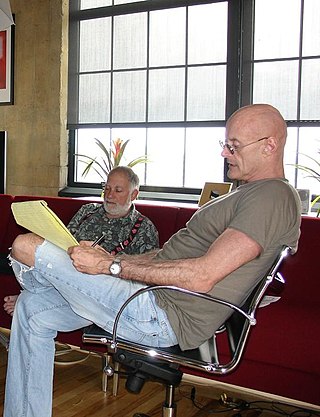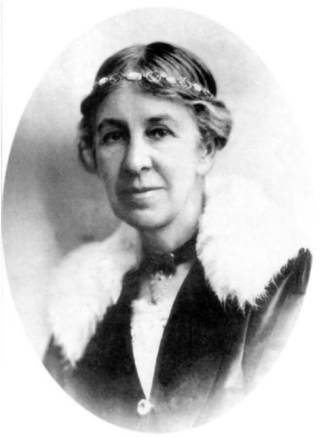In philosophy, the self is the relationship of an individual’s own being, knowledge and values. Self relates the experiences of one's inner and outer living in presence.
Ātman is a Sanskrit word that refers to the (universal) Self or self-existent essence of individuals, as distinct from ego (Ahamkara), mind (Citta) and embodied existence (Prakṛti). The term is often translated as soul, but is better translated as "Self", as it solely refers to pure consciousness or witness-consciousness, beyond identification with phenomena. In order to attain moksha (liberation), a human being must acquire self-knowledge.

Kenneth Earl Wilber II is an American philosopher and writer on transpersonal psychology and his own integral theory, a philosophy which purports to encompass all human knowledge and experience.

Advaita Vedanta is a school of Hindu philosophy and a Hindu sādhanā, a path of spiritual discipline and experience. In a narrow sense it refers to the oldest extant scholarly tradition of the orthodox Hindu school Vedānta, written in Sanskrit; in a broader sense it refers to a popular, syncretic tradition, blending Vedānta with other traditions and producing works in vernacular.
The following outline is provided as an overview of and topical guide to spirituality:

Evelyn Underhill was an English Anglo-Catholic writer and pacifist known for her numerous works on religion and spiritual practice, in particular Christian mysticism. Her best-known is Mysticism, published in 1911.
Spiritual evolution, also called higher evolution, is the idea that the mind or spirit, in analogy to biological evolution, collectively evolves from a simple form dominated by nature, to a higher form dominated by the Spiritual or Divine. It is differentiated from the "lower" or biological evolution, and thought to be foreshadowed by enlightened beings who have already evolved to this advanced stage.
Nonduality, also called nondual awareness, pure awareness and pure consciousness, refers to the concept of a basic awareness without discursive thought or dichtomies, which can be found in numerous spiritual and religious traditions. It is a fuzzy concept originating in Indian philosophy and religion, including Advaita Vedanta, Kashmir Shaivism, and Mahayana Buddhism, for which multiple definitions can be found. In a more general sense, nonduality refers to "the interconnectedness of everything," forming a "singular wholeness of existence that suggests that the personal self is an illusion."
A. H. Almaas is the pen name of A. Hameed Ali, a Kuwaiti American author and spiritual teacher who writes about and teaches an approach to spiritual development informed by modern psychology and therapy which he calls the Diamond Approach. "Almaas" is the Arabic word for "diamond". Almaas is originally from Kuwait. He is the spiritual head of the Ridhwan School.

Integral yoga, sometimes also called supramental yoga, is the yoga-based philosophy and practice of Sri Aurobindo and The Mother. Central to Integral yoga is the idea that Spirit manifests itself in a process of involution, meanwhile forgetting its origins. The reverse process of evolution is driven toward a complete manifestation of spirit.
Scholarly approaches to mysticism include typologies of mysticism and the explanation of mystical states. Since the 19th century, mystical experience has evolved as a distinctive concept. It is closely related to "mysticism" but lays sole emphasis on the experiential aspect, be it spontaneous or induced by human behavior, whereas mysticism encompasses a broad range of practices aiming at a transformation of the person, not just inducing mystical experiences.
Ego death is a "complete loss of subjective self-identity". The term is used in various intertwined contexts, with related meanings. Jungian psychology uses the synonymous term psychic death, referring to a fundamental transformation of the psyche. In death and rebirth mythology, ego death is a phase of self-surrender and transition, as described by Joseph Campbell in his research on the mythology of the Hero's Journey. It is a recurrent theme in world mythology and is also used as a metaphor in some strands of contemporary western thinking.
Higher consciousness is the consciousness of God or, in the words of Dawn DeVries, "the part of the human mind that is capable of transcending animal instincts". While the concept has ancient roots, it was significantly developed in German idealism, and is a central notion in contemporary popular spirituality, including the New Age movement.

Enlightenment is a concept found in several religions, including Buddhist terms and concepts, most notably bodhi, kensho, and satori. It represents kaivalya and moksha (liberation) in Hinduism, Kevala Jnana in Jainism, and ushta in Zoroastrianism.
Integral theory is a synthetic metatheory developed by Ken Wilber. It attempts to place a wide diversity of theories and models into one single framework. The basis is a "spectrum of consciousness," from archaic consciousness to ultimate spirit, presented as a developmental model. This model is based on development stages as described in structural developmental stage theories; various psychic and supernatural experiences; and models of spiritual development. In Wilber's later framework, the AQAL model, it is extended with a grid with four quadrants, synthesizing various theories and models of individual psychological and spiritual development, of collective mutations of consciousness, and of levels or holons of neurological functioning and societal organisation, in a metatheory in which all academic disciplines and every form of knowledge and experience are supposed to fit together.

Mysticism is popularly known as becoming one with God or the Absolute, but may refer to any kind of ecstasy or altered state of consciousness which is given a religious or spiritual meaning. It may also refer to the attainment of insight in ultimate or hidden truths, and to human transformation supported by various practices and experiences.
Self-realization is a term used in western psychology, philosophy, and spirituality; and in eastern Indian religions. In the western understanding, it is the "fulfillment by oneself of the possibilities of one's character or personality". In the Indian understanding, self-realization is liberating knowledge of the true Self, either as the permanent undying Purusha or witness-consciousness, which is atman (essence), or as the absence (sunyata) of such a permanent Self.
Suzanne Segal (1955–1997) was an American writer and teacher about spiritual enlightenment, known for her sudden experience of self-realization which she wrote about in her book Collision With the Infinite: A Life Beyond the Personal Self.

The Marriage of Sense and Soul: Integrating Science and Religion is a 1998 book by American author Ken Wilber. It reasons that by adopting contemplative disciplines related to Spirit and commissioning them within a context of broad science, that "the spiritual, subjective world of ancient wisdom" could be joined "with the objective, empirical world of modern knowledge". The text further contends that integrating science and religion in this way would in turn, "have political dimensions sewn into its very fabric".
Jivatva means – the state of life or the state of the individual soul. Jivatva is the state of life of the Jiva, the living entity, which is a particular manifestation of Atman, the embodied being limited to psycho-physical states, and the source of avidya that suffers (repeated) transmigration as result of its actions. Until ignorance ceases the Jiva remains caught in experience of the results of actions bringing merit and demerit, and in the state of individuality (jivatva), and so long as the connection with the intellect as conditioning adjunct lasts, so long the individuality and transmigration of soul lasts.






